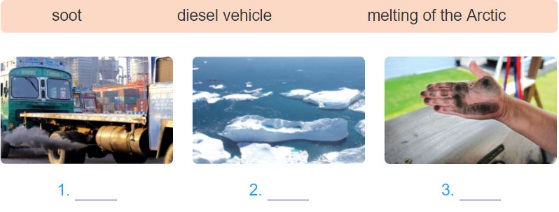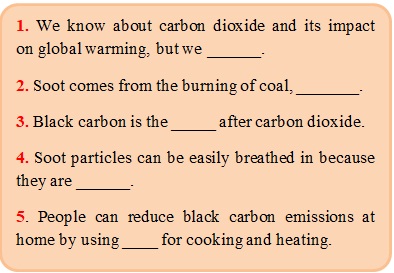Tiếng Anh 12 mới Unit 3 Reading - Đọc hiểu
Tóm tắt bài
1. Unit 3 Lớp 12 Reading Task 1
Look at the pictures. Match the pictures with the appropriate word or phrases. (Nhìn vào những bức tranh. nối những hình ảnh với các từ hoặc cụm từ thích hợp.)

Guide to answer
1. diesel vehicle (xe động cơ diesel)
2. melting of the Arctic (tan chảy băng ở Bắc Cực)
3. soot (bồ hóng, bụi than)
2. Unit 3 Lớp 12 Reading Task 2
Read the following article about soot pollution. Choose the appropriate heading (a-d) for each paragraph. (Đọc bài viết sau về ô nhiễm bụi than. Chọn tiêu đề thích hợp (a-d) cho mỗi đoạn.)
a. Soot and global warming
b. The effect of soot on human health
c. The origin of soot
d. Ways to reduce soot emissions
Nowadays we know a lot about the link between carbon dioxide (C02) emissions and global warming. However, we seem to be unaware of one very dangerous pollutant, soot also called black carbon.
1.________
Soot comes from the incomplete combustion or coal, oil, wood and other fuels. In other words diesel
engines, vehicle exhaust pipes, farming machines, construction equipment, or simply fires in grills, fireplaces, and stoves are potential sources of soot. It appears in our daily life and can easily affect every one of us.
2._______
Soot like all black things absorbs sunlight and heats up the atmosphere. According to recent research, it is the second most damaging greenhouse gas after C02, and twice as harmful to the climate. Although black carbon remains in the atmosphere for no more than seven days it is particularly damaging to frozen areas. Soot emissions might be responsible for the quick melting of the Arctic. Controlling black carbon can help to slow down global warming.
3._______
Soot does not only have an impact on globs warming and climate change, but is also unhealthy. A soot particle is very tiny - smaller than dust and mould, and about 1/30 the width of a human hair. It can easily go into our bloodstream and lungs via the nose and throat. As a result, breathing in the tiny particles car cause asthma attacks, heart disease, bronchitis and many other respiratory illnesses.
4._______
Large quantities of man-made soot enter the atmosphere every year. The effects are most damaging regionally, especially in South and East Asia, Latin America and parts of Africa. In developing countries, reducing soot emissions can be achieved by replacing traditional stoves with clean, alternative fuel cookers and heaters. Installation of filters to remove black carbon from diesel vehicles can also reduce soot. Changing to electric or hydrogen vehicles will also reduce the impact on the environment.
In conclusion, reducing black carbon will have immediate benefits in slowing down global warming and the melting of the Arctic snow and ice. It would also prevent many soot-related deaths and illnesses.
Guide to answer
|
1. c |
2. a |
3. b |
4. d |
- Đoạn 1: "... are potential sources of soot" (là nguồn tiềm năng của bụi than) => nguồn gốc của bụi than
- Đoạn 2: những cụm từ như "damaging greenhouse", "quick melting of the Arctic", "global warming."... => liên quan đến global warming.
- Đoạn 3: những cụm từ "unhealthy", "...bloodstream and lungs", "asthma attacks, heart disease, bronchitis and many other respiratory illnesses." => những bệnh gây ra bởi bụi than tới sức khỏe con người.
- Đoạn 4: by ... replacing traditional stoves with clean, alternative fuel cookers and heaters. " => cách giảm bụi than
3. Unit 3 Lớp 12 Reading Task 3
Work in pairs. Complete each of the following sentences with no more than five words. (Làm việc theo cặp. Hoàn thành mỗi câu sau đây với không nhiều hơn năm từ.)

Guide to answer
1. We know about carbon dioxide and its impact on global warming, but we know little about soot./don't know much about soot. (Chúng tôi biết về carbon dioxide và tác động của nó đối với việc nóng lên toàn cầu, nhưng chúng ta biết rất ít về bụi than / không biết nhiều về bồ hóng.)
2. Soot comes from the burning of coal, oil, wood, and other fuels. (Bồ hóng đến từ việc đốt than, dầu, gỗ, và các nhiên liệu khác.)
3. Black carbon is the second most damaging greenhouse gas after carbon dioxide. (Cacbon đen là khí nhà kính gây tổn hại thứ hai sau khi carbon dioxide.)
4. Soot particles can be easily breathed in because they are smaller than dust and mould/very tiny. (Bồ hóng có thể dễ dàng hít vào người bởi vì chúng nhỏ hơn bụi và nấm mốc / rất nhỏ.)
5. People can reduce black carbon emissions at home by using clean, alternative fuel stoves for cooking and heating. (Mọi người có thể làm giảm lượng khí thải carbon đen ở nhà bằng cách sử dụng bếp nhiên liệu sạch thay thế để nấu ăn và sưởi ấm.)
4. Unit 3 Lớp 12 Reading Task 4
Discuss with a partner. Are soot emissions a problem in your community or in Viet Nam in general? (Thảo luận với một người bạn. Chất thải bụi than là một vấn đề trong cộng đồng của bạn hay ở Việt Nam nói chung?)
Guide to answer
- the effect of soot on the environment and human health
- Soot does not only have an impact on globs warming and climate change, but is alsc unhealthy.
- It can easily go into our bloodstream and lungs via the nose and throat. As a result, breathing in the tiny particles car cause asthma attacks, heart disease, bronchitis and many other respiratory illnesses.
5. Trắc nghiệm Unit 3 Lớp 12 Reading
Như vậy là các em đã xem qua bài giảng phần Unit 3 The Green Movement - Reading chương trình Tiếng Anh lớp 12 mới về chủ đề Cách mạng xanh. Để củng cố kiến thức bài học mời các em tham gia bài tập trắc nghiệm Trắc nghiệm Unit 3 lớp 12 mới Reading.
-
Câu 1: Read the following passage and mark the letter A, B, C or D to indicate the correct answer to each of the questions. Coral reefs are the most diverse of all marine ecosystems. They are full of life, with perhaps one quarter of all ocean species depending on reefs for food and shelter. This is a remarkable statistic when you consider that reefs cover just a tiny fraction of the earth's surface and less than two per cent of the ocean bottom. Because they are so diverse, coral reefs are often called the rainforests of the ocean. Coral reefs are very important to people. They even provide seventy per cent of the food demands for some marine species, protection of shorelines, jobs based on tourism (nine out of twelve activities for tourists in Nha Trang, for example, involve the coral reefs), and even medicines. Unfortunately, climate change is the greatest global threat to coral reef ecosystems. Scientific evidence now clearly indicates that the Earth's atmosphere and ocean are warming, and that these changes are primarily due to greenhouse gases derived from human activities. As temperatures rise, mass coral bleaching events and infectious disease outbreaks are becoming more frequent. Additionally, carbon dioxide absorbed into the ocean from the atmosphere has already begun to reduce calcification rates in reef-building and reef-associated organisms by altering seawater chemistry through decreases in pH. This process is called ocean acidification. Climate change will affect coral reef ecosystems, through sea level rise, changes to the frequency and intensity of tropical storms, and altered ocean circulation patterns. When combined, all of these impacts dramatically alter ecosystem function, as well as the goods and services coral reef ecosystems provide to people around the globe. There are also many things you can do to ensure that you are environmentally conscious when you visit coral reefs or coastal areas. These include things such as hiring local guides to support the economy, removing all trash from an area, never touching or harassing wildlife in reef areas, and avoiding dropping your boat anchor or chain nearby a coral reef. Finally, stay informed and spread the word! Educate yourself about why healthy coral reefs are valuable to the people, fish, plants, and animals that depend on them. Your excitement will help others get involved.
Though the coverage of coral reefs on the sea bed is ____, its vital role is undeniable.
- A. remarkable
- B. small
- C. diverse
- D. huge
-
- A. Two per cent
- B. Seventy per cent
- C. Twenty-five per cent
- D. Nine per cent
Xem thêm Câu 3 - Câu 5 trong trắc nghiệm online
6. Hỏi đáp Unit 3 Lớp 12 Reading
Nếu có gì chưa hiểu các em có thể đặt câu hỏi với cộng đồng Tiếng Anh HOCTAP247 ở mục Hỏi đáp để được giải đáp nhanh nhất. Sau bài học này các em chuyển qua bài học kế tiếp. Chúc các em học tốt!
Copyright © 2021 HOCTAP247
